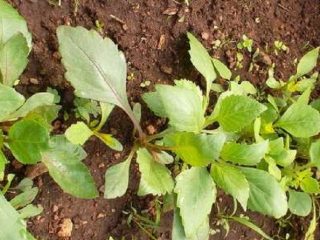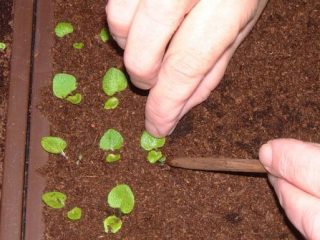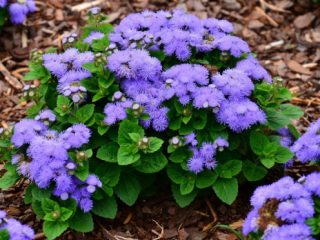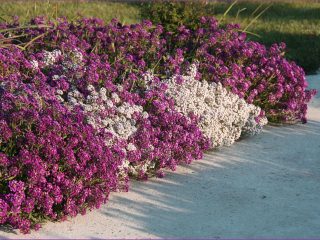Content
- 1 What does vegetative petunia mean?
- 2 What is the difference between vegetative petunia and seed petunia?
- 3 The best varieties of vegetative petunia with names and photos
- 4 How to grow vegetative petunia
- 5 How to care for vegetative petunia
- 6 How to preserve vegetative petunia in winter
- 7 Diseases and pests
- 8 Conclusion
Petunia is one of the most common flower crops, which delights gardeners with its diversity. And due to the development of breeding technologies, more and more colorful and unusual varieties are being born, but the usual seed method is not suitable for breeding them. In this case, cuttings are used - propagation, which allows you to preserve all the qualities of the mother plant. Vegetative petunia has a fast pace of development, blooms profusely and very brightly, and is also considered unpretentious.

Vegetative petunias are used for growing not only in garden plots, but also on window sills
What does vegetative petunia mean?
Vegetative petunia is a plant that is bred exclusively by cuttings. This is done in order to preserve all varietal characteristics, since seed propagation may result in seedlings of unknown quality. In addition, seed from hybrid plants often does not sprout at all.
What is the difference between vegetative petunia and seed petunia?
Petunia is presented in a wide range of appearance and colors, but the vegetative group usually includes ampelous varieties with double flowers. There are also a number of other botanical features of such ornamental plants:
- root system of taproot type, superficial, with poorly developed lateral branches;
- erect or creeping form;
- the stem is strong, the leaf blades are rich green with slight hairiness;
- do not require pinching, usually grow no more than 80 cm;
- have an early flowering period;
- funnel-shaped flowers with five petals fused together;
- after flowering they do not form seeds or they are unsuitable for sowing.
The best varieties of vegetative petunia with names and photos
The propagation of vegetative petunia is practically no different from the cuttings of other species of this crop, but in terms of external indicators the differences are very noticeable. To make sure of this, you can consider the most popular varieties.
Surfinia
Surfinia is a variety of hybrid petunia bred in Japan. The plant was introduced in the 70s of the last century, and in a short period of time it was able to win the trust of many gardeners. Surfinia gained such popularity due to its unpretentiousness, resistance to adverse environmental factors and beautiful appearance.
The main distinguishing feature of Surfinia is its funnel-shaped flowers with a diameter of 2 to 7 cm, resistant to precipitation and strong winds. Their shade varies depending on the variety, ranging from snow-white to deep red.Young seedlings of this vegetative petunia are quite large, producing many side shoots.

Surfinia blooms early and abundantly
Cardinal
Cardinal is a variety of vegetative petunia, characterized by rapid growth and abundant flowering. The bushes reach 90-100 cm, while they are unpretentious in cultivation. The flowers are also large with corrugated edges, their color is bright purple.
Petunia Cardinal blooms in the first half of June and delights with beautiful flowers until the beginning of October.

Petunia Cardinal can have solid flowers, as well as with dark veins or contrasting edging
Cascadias
Vegetative petunia Cascadias came to Russian gardens from Israel in 2010. It belongs to the cascade species, since the shoots mainly in the central part grow upward and fit tightly to each other. The plant blooms profusely. The buds have a color that varies from dark cherry to purple.
Propagating vegetative petunia Cascadias at home is not difficult, as young seedlings take root quickly. But it is advisable to grow it in open ground or use it for planting pots at least 7-8 liters deep.

Vegetative petunia Cascadias has a powerful root system
Frillitunia
Vegetative petunia Frillytunia forms neat, dense bushes with large, simple greenery. It grows up to 40 cm in height, while the flowers form quite large, up to 10 cm in diameter. The buds are funnel-shaped with a solid corolla and a dark throat of the inflorescence. The edges are heavily corrugated. Colors can be white, pink, cherry and purple.
Frillitunia blooms no earlier than the first half of June and pleases with its flowering until the first frost.

Frillitunia has varieties that differ only in color
Papaya
Papaya is a vegetative petunia that attracts attention with lush, long-lasting flowering. The buds completely cover the bush so that the green mass is practically invisible.
The ornamental plant grows up to only 20 cm and forms orange funnel-shaped buds. Some varieties have a white border along the edge of the fused petals.

Vegetative petunia Papaya is represented by one- and two-color varieties
How to grow vegetative petunia
Vegetative petunia is bred by cuttings. At the same time, growing a young ornamental plant in this way has a number of advantages:
- unlike the seed method, cuttings are less time-consuming, because the shoots quickly take root;
- flowering begins earlier;
- When cuttings, all the qualities of the mother bush are preserved.
Planting material is used only from a healthy bush. And for cuttings of vegetative petunia, shoots are prepared for the winter. They are cut at an angle about 6-8 cm long so that there are two internodes. The lower leaves are removed and then the cuttings are dipped into a growth stimulator. For rooting, planting material is dropped into a nutrient substrate. It can be used universally or mixed independently.
The planting is covered with film to create a greenhouse effect. Ventilate and moisturize daily. And when the first full-fledged leaves appear, the covering material is removed, and at this moment pinching can be done to stimulate the formation of lateral shoots.
As soon as at least four leaves appear, the young seedling is transplanted into open ground or into a flowerpot. It is advisable to choose a place that is sunny and hidden from draft winds.
When growing vegetative petunia in pots, it can be stored until next year. To do this, it is enough to bring the plantings into a warm room.
How to care for vegetative petunia
Caring for vegetative petunia is practically no different from growing an ordinary variety of this crop. The main requirements are as follows:
- lighting - the flower loves light, so it is better to plant it in sunny areas, but it is important to ensure that the buds are not exposed to direct sunlight to avoid burns;
- temperature – it must be at least +10 ºC and no more than +30 ºC.
For care, it is enough to timely water the vegetative petunia. Moisten the soil at least twice a week; on hot days, the amount of irrigation can be increased up to three times.
The ornamental plant responds well to fertilizing. It is recommended to fertilize the soil during planting once every two weeks, alternating mineral and organic compounds.
How to preserve vegetative petunia in winter
Vegetative petunia does not tolerate low temperatures well, therefore, in order to preserve the plant in winter, it should be brought indoors. Before this, they begin to reduce watering, and then sanitize the bush, removing dry and damaged shoots and leaves. They also stop feeding the flower so as not to stimulate its further development.
It is usually recommended to store vegetative petunia in winter for its further propagation, since cuttings after cutting easily lose their ability to root if they are not placed in water or nutrient soil.

After cutting, the cuttings of vegetative petunia retain the ability to root for only 1-2 hours
Diseases and pests
Vegetative petunia, like any ornamental plant, is subject to disease and attack by pests. The most dangerous are considered:
- black leg - the disease is characterized by the appearance of dark spots on the stems and rot due to waterlogging;
Bordeaux mixture or Trichodermatitis is used to combat blackleg.
- brown spot is the appearance of dark brown spots on the leaves due to excessive waterlogging;
Copper-containing preparations are used to treat brown spot.
- powdery mildew can be recognized by the appearance of a white coating on the leaves and stems; the cause may be sudden changes in temperature;
When powdery mildew appears, the affected areas are removed and the plant is treated with a fungicidal preparation.
- gray rot is the formation of spore-bearing gray spots that appear when there is a lack of lighting and the introduction of a large amount of nitrogenous fertilizers.
If detected, a diseased plant is completely removed and burned, while others are treated with Topaz or Fitosporin
In addition to dangerous diseases, vegetative petunia often suffers from attacks by pests. Among the most common are:
- whitefly;
- aphid;
- spider mite
For small lesions, you can use folk remedies (soap solution, onion peel decoction, etc.) to control pests. In case of a mass attack, it is better to use insecticidal preparations: Aktara, Condifor, Decis and others.
Conclusion
Vegetative petunia is an ornamental plant with magnificent flowering that looks great both in a flower bed and on a windowsill. The culture is unpretentious in care, because for full development it is enough to water and feed it in a timely manner.












